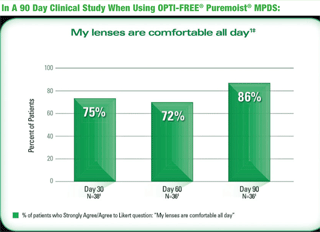 The professional marathoner goes the distance largely due to talent and dedication, but ultimately her success hinges on several additional well-integrated components. Coaching, training, nutrition and customized running shoes each play an important role. Think of it this way: having the right stuff can only take you so far—performance variables must be optimized to win.
The professional marathoner goes the distance largely due to talent and dedication, but ultimately her success hinges on several additional well-integrated components. Coaching, training, nutrition and customized running shoes each play an important role. Think of it this way: having the right stuff can only take you so far—performance variables must be optimized to win.
The same concepts may be applied to our contact lens wearers. They are motivated to wear their lenses for a full day and rely upon them to go the distance—to provide comfort and clarity from insertion to removal. Furthermore, patients desire and expect their contact lenses to perform well under a variety of challenging conditions including prolonged stretches on the computer, while driving and in drier environments such as office buildings or air-conditioned malls. As practitioners, we function as the professional coach or trainer and it is incumbent upon us to ensure that important modifiable clinical variables are optimized.
A Three Step Process
 |
| ‡Subset of patients who reported an average wear time of 16 hours or more at each visit.
Tested with Acuvue 2*, Acuvue Oasys*, Air Optix® Aqua, Biofinity*, PureVision*, and SofLens* 38 lenses. 1. Data on file, Alcon Research Ltd. *Trademarks are the property of their respective owners. |
- First, proactively address any pre-existing ocular surface deficiencies with appropriate supportive therapies such as artificial tears, nutritional supplements, pharmacologic and mechanical intervention.
- Second, methodically determine which of the latest array of improved contact lens materials—silicone hydrogels, water-balanced HEMA, moisture rich polymers and lubricant “eluting” lenses—provides the best option for each individual patient. Since there is no definitively empirical way to predict which material will work best in any given case, work with as many as possible for maximum success.
- After optimizing the condition of the ocular surface and selecting the most suitable lens material, the remaining challenge is to foster the retention of moisture both on and within the lens. The contact lens’ affinity for moisture, as well as the duration of tear retention to the lens surface, can be expected to impact our patients’ lens wearing experience and, in particular, the number of comfortable wearing hours. Fortunately, knowledgeable consideration of the differences between lens care products and educated choice of the lens care solution provides us with the opportunity to influence key variables related to lens wettability.
Alcon’s newly formulated OPTI-FREE® PureMoist® MPDS is specifically designed to attract and hold moisture within and on today’s advanced contact lens materials. The proprietary HydraGlyde® Moisture Matrix transforms surface and internal hydrophobic components of the contact lens polymer into hydrophilic ones, by embedding itself both within and on the lens surface. Most importantly, this transformation has been demonstrated up to the point when a patient removes their lenses, simulating a full day of contact lens wear.2
With careful clinical attention to ensuring a healthy ocular surface, strategic selection of contact lens material, and by recommending OPTI-FREE® PureMoist® MPDS, we can help patients achieve their goal of going the distance by delivering comfortable contact lens wear from insertion to removal.
2. Davis J, Ketelson HA, Shows A. A Lens care solution designed for wetting silicone hydrogel materials. Poster presented at the Association for Research in Vision and Ophthalmology meeting, May 2-6, 2010; Ft. Lauderdale, Fla.


